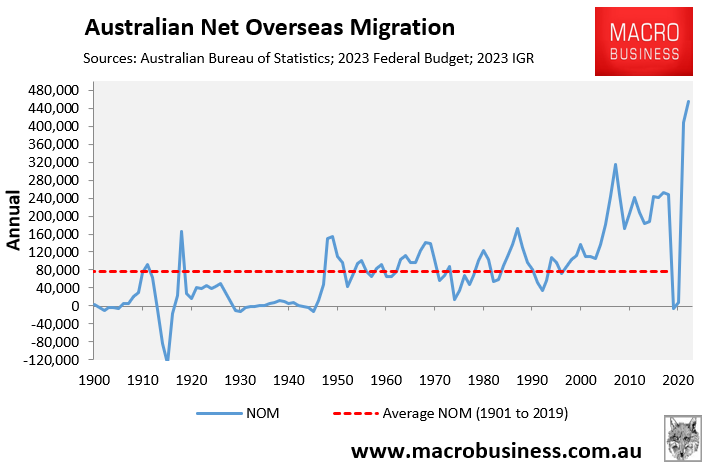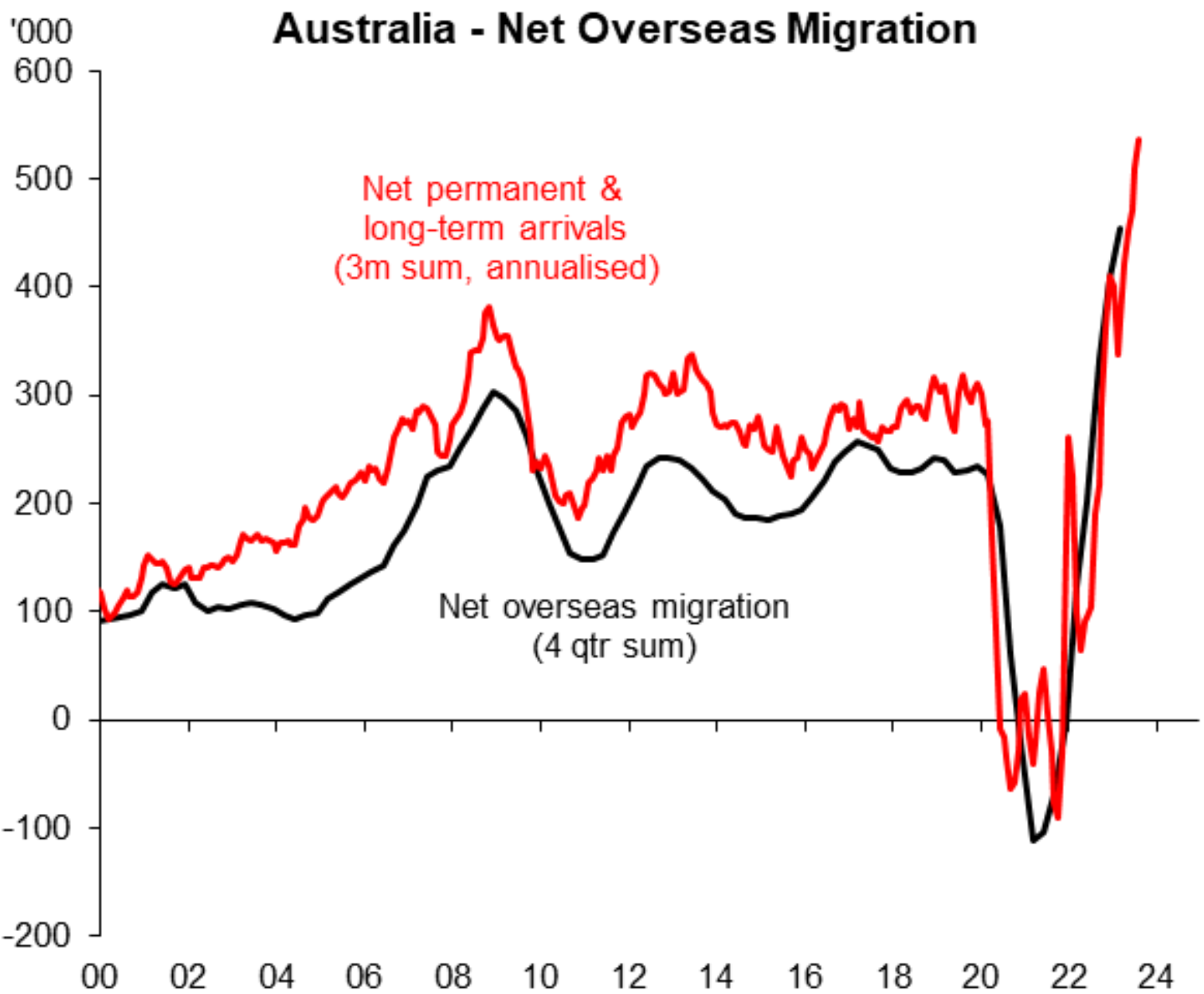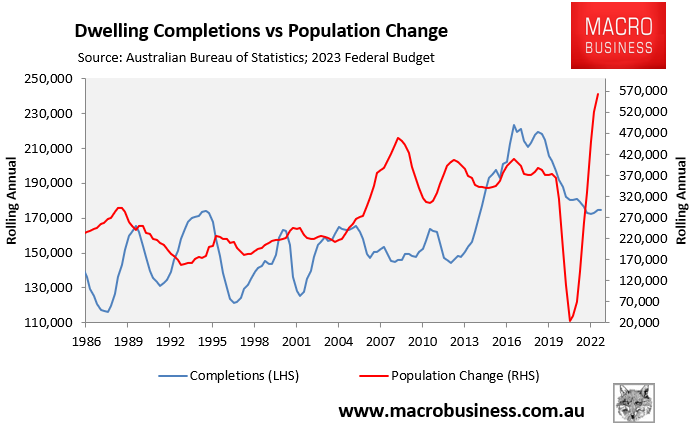The rental market in Australia has completely gone mad.
According to the most recent rental vacancy statistics from CoreLogic, PropTrack and SQM Research, Australia’s capital city vacancy rate fell to an all-time low of around 1.0% in September, with every market in Australia suffering exceptional tightness:

Source: CoreLogic
The scarcity of available rental properties has pushed rental inflation to its highest level in decades, with PropTrack recording 12.2% growth in capital city rents in the year to September, driven by 18.2% growth in Sydney, 14.9% growth in Perth, and 13.6% growth in Melbourne:

PropTrack blamed the Albanese government’s record immigration program for the tight rental market:
“The ongoing rapid rate of population growth, coupled with a persistent reduction in the supply of properties available for rent, have maintained the pressure on the cost of renting, particularly in major capital cities”.
According to the Australian Bureau of Statistics’ (ABS) official quarterly population data, Australia added an unprecedented 454,300 net overseas migrants in the year to March:

The ABS’s monthly long-term arrivals and departures figures imply that net overseas migration (NOM) has risen even more, with around 500,000 net migrants predicted to arrive in Australia during the financial year 2022-23:

Source: Justin Fabo (Macquarie Group)
This amount of immigration will easily exceed the 400,000 NOM predicted in the May federal budget for the 2022-23 financial year:

Source: 2023 Federal Budget
The immigrant boom has coincided with the collapse of housing construction.
In Australia, just 175,200 homes were built in the year to March 2023, despite a population increase of 563,200.
According to the ABS, only 169,500 dwellings were added to the nation’s dwelling stock in the 2022-23 financial year, reflecting that some of the homes built were ‘knock down and rebuilds’ and thus did not contribute to overall supply.
The number of supply additions was comprehensively dwarfed by the 626,000 estimated increase in Australia’s resident population in the June quarter ABS national accounts.
Housing supply will not be able to keep up with demand:
The May federal budget anticipated that Australia’s population will grow by 2.18 million people (equal to the population of Perth) over the five years to 2026-27, driven by a NOM of 1.5 million people (similar to the population of Adelaide).
The following chart compares the expected population increase in the federal budget to actual dwelling completions as reported by the ABS:

Remember that Australia’s population is currently growing more quickly than the federal budget’s projections.
Regardless, Australia is on the verge of a historic housing crisis unless it can rapidly increase housing supply to match abnormally high levels of immigration.
The National Cabinet announced in August a five-year plan to build 1.2 million new dwellings beginning on 1 July, 2024.
However, the federal, state, and territory governments will not actually build these 1.2 million dwellings. Their strategy is to ease planning and zoning laws to allow for greater density in the hopes that private developers will build them.
Eleanor Creagh, senior economist at PropTrack, cautioned this month that “to meet the 1.2 million goal, we need to increase our pace of building by almost 40% from where it currently stands”.
To make matters worse, “based on current estimated annual growth of close to 600,000+ people per year (both natural increase and net overseas migration), the new residents will simply absorb the 1.2 million homes based on an average household size of 2.49”, Creagh warned.
There are significant reasons to believe the National Cabinet’s 1.2 million housing objective will never be met.
First, developers will not want to overwhelm the market with supply since it will lower their profits. Private developers have an inherent incentive to drip-feed supply in order to keep prices elevated.
Second, the National Cabinet wants the market to construct 240,000 dwellings every year, or 660 homes per day. Australia, on the other hand, has only ever built more than 220,000 dwellings in a single year once, in 2017, when it built 223,000.
Australia’s 40-year average housing construction rate is only 160,000, which is 80,000 fewer than the target set by National Cabinet.
How will Australia realistically build more homes than ever before in the face of widespread building failures, material and labour shortages, and higher interest rates?
Third, what about the infrastructure required to support this increased in housing and population? Most of our main capital cities’ roads, schools, and hospitals are already at capacity.
Finally, even if we could magically build these 1.2 million homes, they would almost certainly be of poor quality.
The previous decade’s construction boom was accompanied with widespread faults such as cracking, water leaks, and balcony issues, particularly in apartment buildings (e.g., Sydney’s Opal and Mascot Towers).
Building so many apartments as quickly as National Cabinet intends will inevitably reduce quality, resulting in the same types of structural difficulties we saw last decade.
The rental crisis in Australia will deepen:
Because there are too many people competing for too few homes, Australia’s rental problem will undoubtedly deteriorate, and the number of Australians living in share housing or becoming homeless will rise.
Already, the number of people looking for share accommodation on Flatmates.com.au, the country’s largest share house website, has nearly doubled.
National Shelter also projected a 50% increase in homelessness between 2020 and 2022, as well as a 103% increase in persons living in “improvised homes” and “rough sleeping”:

It is an impending inequality crisis that will disproportionately impact the younger and poorer generations of Australians.
Lowering immigration levels are the key housing solution:
The chronic housing shortage in Australia is a direct outcome of nearly two decades of excessive immigration, which has reached new heights this year and is officially expected to continue indefinitely.
The reality is that Australia will never be able to build enough homes as long as its population grows at a rapid pace due to high levels of immigration.
During the 15 years of ‘Big Australia’ immigration preceding the pandemic, the country did not build enough homes.
We have even less chances now, with even higher levels of immigration and the entire housing construction sector on the verge of collapse due to widespread insolvency and soaring material and financing (interest rate) costs.
If the Albanese Government truly cared about resolving Australia’s housing crisis, it would limit immigration to a level that is less than the nation’s ability to deliver housing and infrastructure, not the other way around.
Governments and housing experts must stop pretending that a ‘lack of supply’ is the issue and address the immigration elephant in the room that is trampling the housing market and tenants.

